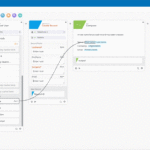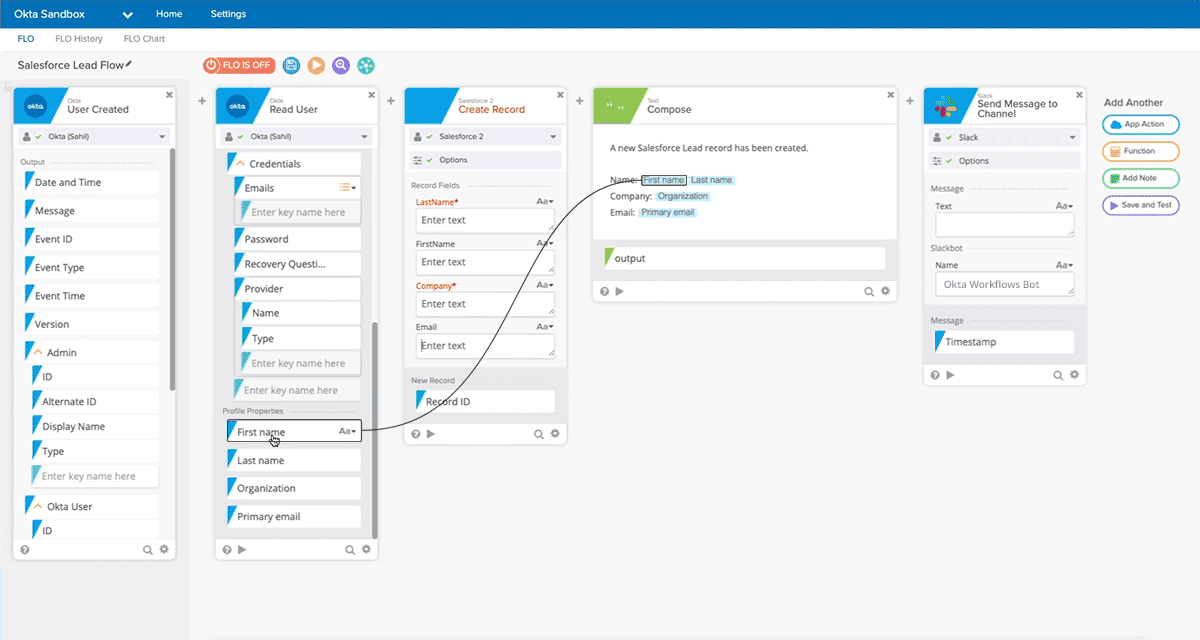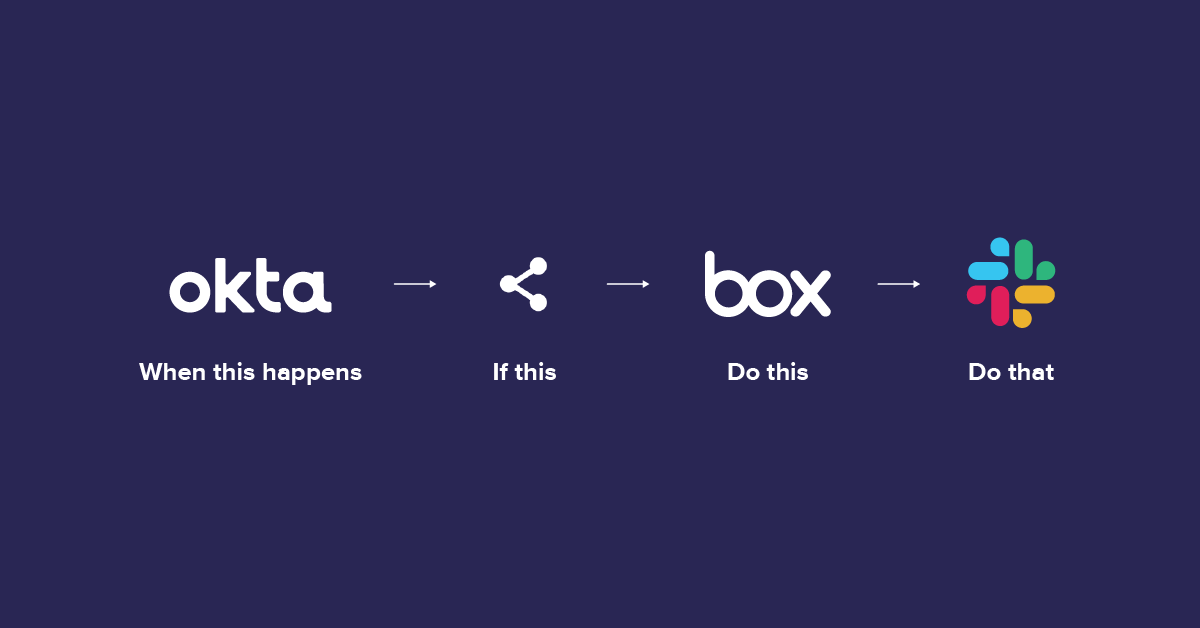Okta launches Lifecycle Management Workflows to make building identity-centric processes easy
Okta, the popular identity and access management service, today used its annual (and now virtual) user conference to launch Lifecycle Management Workflows, a new tool that helps IT teams build and manage IFTTT-like automated processes with the help of an easy to use graphical interface.
The new service is an extension of Okta’s existing automation tools. But the key here is that IT teams and developers can now easily build complex identity-centric workflows across a wide range of applications. With this, these teams can easily automate an onboarding process, where setting up a new Okta account also immediately kicks off processes on third-party services like Box, Salesforce, ServiceNow and Slack to set up accounts there. The same goes for offboarding workflows and username creation. A lot of companies still do this manually, which is not just a hassle but also error-prone.
“Adopting more technology is incredibly beneficial for enterprises today, but complexity is a significant side effect of a changing technology ecosystem and workforce. There is no better example of the potential challenges it can create than with lifecycle management,” said Diya Jolly, chief product officer at Okta. “Okta’s vision of enabling any organization to use any technology goes deeper than just access; it’s about improving how organizations use technology. Okta Lifecycle Management Workflows improves the efficiency and security of enterprises through its simple user experience and broad applicability, keeping organizations secure and efficient without requiring the complexity of writing code.”
Okta, of course, had lifecycle management features before, but now it is also putting its acquisition of Azuqua to work and using that company’s graphical interface and technology for making it easier to create these automation processes. And while the focus right now is on processes like provisioning and de-provisioning accounts, the long-term plan is to expand Workflows with support for more identity processes.
As Okta also stresses, administrators can also manage very granular access across the supported third-party tools like assigning territories in Salesforce or access to specific group channels in Slack, for example. For temporary employees, admins can also set up automatic de-provisioning workflows that revoke access to some tools but maybe leave access to payroll services open for a while longer. There are also built-in tools for automatically managing conflicts when two people have the same name.
“Millions of people rely on Slack every day to make their working lives simpler, more pleasant and more productive,” said Tamar Yehoshua, chief product officer at Slack, one of the early adopters of this service. “Okta Lifecycle Management Workflows has significantly increased efficiency for us by automating the provisioning and de-provisioning of users from applications in our environment, without us ever having to write a line of code.”
This new feature is part of Okta’s new Platform Services, which the company also debuted today and which currently consists of core technologies like the Okta Identity Engine, Directories Integrations, Insights, Workflow and Devices. The core idea behind Platform Services is to give Okta users the flexibility to manage their unique identity use cases but also to give Okta itself a platform on which to innovate. One other new product that sits on top of the platform is Okta Fastpass, for example, which allows for passwordless authentication on any device.
Powered by WPeMatico
T-Mobile officially completes merger with Sprint, CEO John Legere steps down ahead of schedule
After months of regulatory maneuvering, T-Mobile and Sprint officially completed their $26 billion merger today. The new combined parent company is called T-Mobile and will now trade on the Nasdaq under the ticker symbol TMUS with Sprint no longer trading on the NYSE.
For consumers, it will seemingly take a little time before the effects of the transition are meaningfully felt. T-Mobile did not comment on the future of the Sprint brand in today’s announcement, but they have previously promised that subscribers will have access to “the same or better rate plans” for three years as part of the deal.
Alongside news of the merger being finalized, T-Mobile shared that its CEO transition is taking place early. John Legere was supposed to stay on until the end of April, but Mike Sievert has been appointed CEO a month early, effective immediately. Sievert was previously T-Mobile’s COO.
Legere has led T-Mobile since 2012, mounting a turnaround at the company framing the service as a low-cost alternative to the duopoly of AT&T and Verizon. (Disclosure: TechCrunch is owned by Verizon Media, but this does not affect our coverage.) The company’s years-long “Un-carrier” marketing push often featured Legere and his antics prominently.
Legere is still on the company’s board of directors, but he’ll be stepping down at the end of his term through June.
Powered by WPeMatico
Mobile app spending to double by 2024, despite economic impacts of COVID-19
The spread of COVID-19 has already had a significant impact on the mobile app industry, and that will continue in the years to come. According to a revised 2020-2024 market forecast from app intelligence firm Sensor Tower, a sizable increase in app downloads for industries like remote work and education will lead to a large surge in app installs for the early part of 2020 and beyond, despite other decreases in downloads for ridesharing and fast food apps. However, the expected economic downturn resulting from COVID-19 will somewhat dampen revenue growth in the years ahead, the report found. Despite this, mobile app spending worldwide will continue to grow and will even double by 2024.
COVID-19’s impact on app stores’ revenue
Though COVID-19 is having an impact on the app stores’ revenue, growth remains strong.
Worldwide consumer spending in mobile apps is projected to reach $171 billion by 2024, which is more than double the $85 billion from 2019. This total, however, is about $3 billion (or 2%) less than the forecast the firm had released prior to the COVID-19 outbreak.
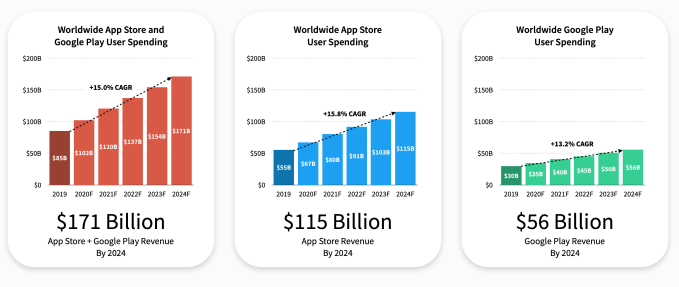
Still, it’s notable that even the slowest-growing regions on both app stores, Apple’s App Store and Google Play, will see revenue that’s over 80% higher than their 2019 levels by the year 2024.
The app stores will also hit several milestones during the next five years.
For starters, global spending in mobile apps will surpass $100 billion for the first time in 2020, growing at approximately 20% year-over-year to hit $102 billion.
Remarkably, the forecast also predicts that revenue from non-game mobile apps is expected to surpass that of mobile games for the first time by 2024, driven by the growth in subscriptions — particularly Entertainment, Social Networking, Music and Lifestyle app subscriptions.
By this time, mobile games will reach $97.8 billion, or around 41% of total consumer spending. The App Store will account for a sizable chunk of that spending, with ~$57 billion in mobile game revenue in 2024 versus Google Play’s ~$41 billion.

The App Store, not as surprisingly, will also maintain its sizable lead in consumer spending through 2024, accounting for 67% of total revenue across both it and Google Play. It will grow at a compound annual growth rate of 15.8% compared with Google Play’s 13.2%.
The top five countries by revenue will remain unchanged through 2024: China, U.S., Japan, Great Britain and Taiwan. China will continue to be a top market, despite regulations on app and game publishing, and will reach $35 billion in App Store spending alone by 2024.
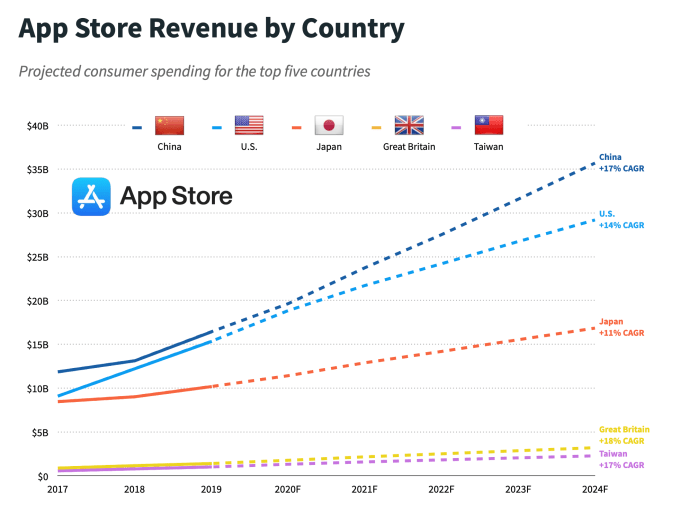
COVID-19’s impact on downloads
In terms of app downloads, the forecast predicts a lasting lift from the impacts of COVID-19.
By 2024, downloads will reach 183.7 billion, up 9% from the earlier forecast that came out before COVID-19 that had initially accounted for 7 billion fewer installs.
Much of this download growth is happening this year, when first-time app downloads are poised to reach 140.3 billion, up 22% from 2019.

In addition to increases in non-game apps — like education, grocery delivery or remote work apps — mobile game downloads will grow 30% year-over-year in 2020 to reach 56.2 billion, compared with 10.4% growth between 2018 and 2019.
By 2024, mobile games will account for 41% of new installs, or 74.8 billion.
The early indication is that China will see a massive increase in downloads in 2020, particularly in the Games and Education categories. This follows a drop in downloads over the past few years, due to government regulatory practices, like the games licensing freeze.
The U.S. will see a similar spike in downloads this year, also due to COVID-19. For 2020, this will lead to a 27% year-over-year increase in downloads. But by 2021 and in the years that follow, growth will settle around 7% annually from 2021 to 2024 in this market.
During the forecast time frame, download growth will slow in India and Brazil, as the markets become more saturated, while growing in Latin America (up 58%) and Asian markets outside of China (up 82%).
Another notable milestone may take place in 2022, when the U.S. pulls ahead of China in terms of App Store downloads to reach number one. The U.S. has been narrowing the gap between the two in recent years, from 3.5 billion in 2017 to 1.1 billion in 2019. It will continue to close the gap during parts of 2020 and 2021, as well.
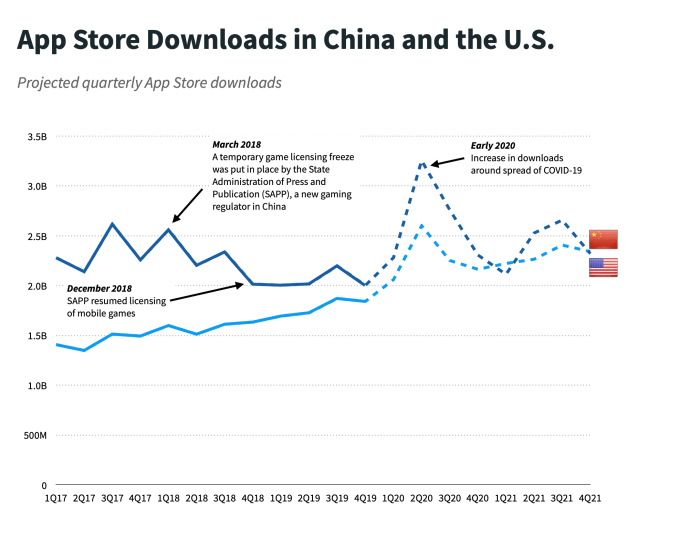
Other top countries for downloads in 2024, besides the U.S. and China, include Japan, Great Britain and Russia.

Powered by WPeMatico
Vericool raises $19.1 million for its plant-based packaging replacement for plastic coolers
Vericool, a Livermore, Calif.-based startup that’s replacing plastic coolers and packaging with plant-based products, has raised $19.1 million in a new round of financing.
The company’s stated goal is to replace traditional packaging materials like polystyrene with plant-based insulating packaging materials.
Its technology uses 100% recycled paper fibers and other plant-based materials, according to the company, and are curbside recyclable and compostable.
Investors in the round include Radicle Impact Partners, The Ecosystem Integrity Fund, ID8 Investments and AiiM Partners, according to a statement.
“We’re pleased to support Vericool because of the company’s track record of innovation, high-performance products, well-established patent portfolio and focus on environmental resilience. We are inspired by the company’s social justice commitment to address recidivism and provide workplace opportunity to formerly incarcerated individuals,” said Dan Skaff, managing partner of Radicle Impact Partners and Vericool’s new lead director.
Powered by WPeMatico
Xerox drops $34B HP takeover bid amid COVID-19 uncertainty
Xerox announced today that it would be dropping its hostile takeover bid of HP. The drama began last fall with a flurry of increasingly angry letters between the two companies, and confrontational actions from Xerox, including an attempt to take over the HP board that had rejected its takeover overtures.
All that came crashing to the ground today when Xerox officially announced it was backing down amid worldwide economic uncertainty related to the COVID-19 pandemic. The company also indicated it was dropping its bid to take over the board.
“The current global health crisis and resulting macroeconomic and market turmoil caused by COVID-19 have created an environment that is not conducive to Xerox continuing to pursue an acquisition of HP Inc. (NYSE: HPQ) (‘HP’). Accordingly, we are withdrawing our tender offer to acquire HP and will no longer seek to nominate our slate of highly qualified candidates to HP’s Board of Directors,” the company said in a statement.
As for HP, it said it was strong financially and would continue to drive shareholder value, regardless of the outcome:
We remain firmly committed to driving value for HP shareholders. HP is a strong company with market leading positions across Personal Systems, Print, and 3D Printing & Digital Manufacturing. We have a healthy cash position and balance sheet that enable us to navigate unanticipated challenges such as the global pandemic now before us, while preserving strategic optionality for the future.
The bid never made a lot of sense. Xerox is a much smaller company, with a market cap of around $4 billion compared with HP with a market cap of almost $25 billion. It was truly a case of the canary trying to eat the cat.
Yet Xerox continued to insist today, even while admitting defeat, that it would have been better to combine the two companies, something HP never felt was realistic. HP questioned the ability of Xerox to come up with such a large sum of money, and, if it did, would it be financially stable enough to pull off a deal like this.
Yet even as recently as last month, Xerox increased the bid from $22 to $24 per share in an effort to entice shareholders to bite. It had previously threatened to bypass the board and go directly to shareholders before attempting to replace the board altogether.
HP didn’t like the hostility inherent in the bid or any of the subsequent moves Xerox made to try to force a deal. Last month, HP offered its investors billions in give-backs in an effort to convince them to reject the Xerox bid. As it turned out, the drama simply fizzled out in the middle of a worldwide crisis.
Powered by WPeMatico
FCC mandates strict caller ID authentication to beat back robocalls
The FCC unanimously passed a new set of rules today that will require wireless carriers to implement a tech framework to combat robocalls. Called STIR/SHAKEN, and dithered over for years by the carriers, the protocol will be required to be put in place by summer of 2021.
Robocalls have grown from vexation to serious problem as predictable “claim your free vacation” scams gave way to “here’s how to claim your stimulus check” or “apply for coronavirus testing here” scams.
A big part of the problem is that the mobile networks allow for phone numbers to be spoofed or imitated, and it’s never clear to the call recipient that the number they see may be different from the actual originating number. Tracking and preventing fraudulent use of this feature has been on the carriers’ roadmap for a long time, and some have gotten around to it in some ways, for some customers.
STIR/SHAKEN, which stands for Secure Telephony Identity Revisited / Secure Handling of Asserted information using toKENs, is a way to securely track calls and callers to prevent fraud and warn consumers of potential scams. Carriers and the FCC have been talking about it since 2017, and in 2018 the FCC said it needed to be implemented in 2019. When that hadn’t happened, the FCC gave carriers a nudge, and at the end of the year Congress passed the TRACED Act to spur the regulator into carrying out its threat of mandating use of the system.
Rules to that effect were proposed earlier this month, and at the FCC’s open meeting today (conducted remotely), the measure passed unanimously. Commissioner Jessica Rosenworcel, who has been vocal about the lack of concrete action on this issue, gladly approved the rules but vented her frustration in a statement:
It is good news that today the Federal Communications Commission adopts rules to reduce robocalls through call authentication. I only wish we had done so sooner, like three years ago when the FCC first proposed the use of STIR/SHAKEN technology.
Commissioner Brendan Starks called the rules a “good first step,” but pointed out that the carriers need to apply call authentication technology not just on the IP-based networks but all over, and also to work with each other (as some already are) to ensure that these protections remain in place across networks, not just within them.
Chairman Ajit Pai concurred, pointing out there was much work to do:
It’s clear that FCC action is needed to spur across-the-board deployment of this important technology…Widespread implementation of STIR/SHAKEN will reduce the effectiveness of illegal spoofing, allow law enforcement to identify bad actors more easily, and help phone companies identify—and even block—calls with illegal spoofed caller ID information before those calls reach their subscribers. Most importantly, it will give consumers more peace of mind when they answer the phone.
There’s no silver bullet for the problem of spoofed robocalls. So we will continue our aggressive, multi-pronged approach to combating it.
Consumers won’t notice any immediate changes — the deadline is next year, after all — but it’s likely that in the coming months you will receive more information from your carrier about the technology and what, if anything, you need to do to enable it.
Powered by WPeMatico
Palo Alto Networks to acquire CloudGenix for $420M
Palo Alto Networks announced today that it has an agreement in place to acquire CloudGenix for $420 million.
CloudGenix delivers a software-defined wide area network (SD-WAN) that helps customers stay secure by setting policies to enforce compliance with company security protocols across distributed locations. This is especially useful for companies with a lot of branch offices or a generally distributed workforce, something just about everyone is dealing with at the moment as we find millions suddenly working from home.
Nikesh Arora, chairman and CEO at Palo Alto Networks, says that this acquisition should contribute to Palo Alto’s “secure access service edge,” or SASE solutions, as it is known in industry parlance.
“As the enterprise becomes more distributed, customers want agile solutions that just work, and that applies to both security and networking. Upon the close of the transaction, the combined platform will provide customers with a complete SASE offering that is best-in-class, easy to deploy, cloud-managed, and delivered as a service,” Arora said in a statement.
CloudGenix was founded 2013 by Kumar Ramachandran, Mani Ramasamy and Venkataraman Anand, all of whom will be joining the company as part of the deal. It has 250 customers across a variety of verticals. The company has raised almost $100 million, according to PitchBook data.
Palo Alto Networks has been on an acquisitive streak. Going back to February 2019, this represents the sixth company it has acquired, to the tune of more than $1.6 billion overall.

The acquisition is expected to close in the fourth quarter, subject to customary regulatory approvals.
Powered by WPeMatico
Microsoft launches Edge Zones for Azure
Microsoft today announced the launch of Azure Edge Zones, which will allow Azure users to bring their applications to the company’s edge locations. The focus here is on enabling real-time low-latency 5G applications. The company is also launching a version of Edge Zones with carriers (starting with AT&T) in preview, which connects these zones directly to 5G networks in the carrier’s data center. And to round it all out, Azure is also getting Private Edge Zones for those who are deploying private 5G/LTE networks in combination with Azure Stack Edge.
In addition to partnering with carriers like AT&T, as well as Rogers, SK Telecom, Telstra and Vodafone, Microsoft is also launching new standalone Azure Edge Zones in more than 10 cities over the next year, starting with LA, Miami and New York later this summer.
“For the last few decades, carriers and operators have pioneered how we connect with each other, laying the foundation for telephony and cellular,” the company notes in today’s announcement. “With cloud and 5G, there are new possibilities by combining cloud services, like compute and AI with high bandwidth and ultra-low latency. Microsoft is partnering with them bring 5G to life in immersive applications built by organization and developers.”
This may all sound a bit familiar, and that’s because only a few weeks ago, Google launched Anthos for Telecom and its Global Mobile Edge Cloud, which at first glance offers a similar promise of bringing applications close to that cloud’s edge locations for 5G and telco usage. Microsoft argues that its offering is more comprehensive in terms of its partner ecosystem and geographic availability. But it’s clear that 5G is a trend all of the large cloud providers are trying to tap into. Microsoft’s own acquisition of 5G cloud specialist Affirmed Networks is yet another example of how it is looking to position itself in this market.
As far as the details of the various Edge Zone versions go, the focus of Edge Zones is mostly on IoT and AI workloads, while Microsoft notes that Edge Zones with Carriers is more about low-latency online gaming, remote meetings and events, as well as smart infrastructure. Private Edge Zones, which combine private carrier networks with Azure Stack Edge, is something only a small number of large enterprise companies would likely to look into, given the cost and complexity of rolling out a system like this.
Powered by WPeMatico
Amid shift to remote work, application performance monitoring is IT’s big moment
In recent weeks, millions have started working from home, putting unheard-of pressure on services like video conferencing, online learning, food delivery and e-commerce platforms. While some verticals have seen a marked reduction in traffic, others are being asked to scale to new heights.
Services that were previously nice to have are now necessities, but how do organizations track pressure points that can add up to a critical failure? There is actually a whole class of software to help in this regard.
Monitoring tools like Datadog, New Relic and Elastic are designed to help companies understand what’s happening inside their key systems and warn them when things may be going sideways. That’s absolutely essential as these services are being asked to handle unprecedented levels of activity.
At a time when performance is critical, application performance monitoring (APM) tools are helping companies stay up and running. They also help track root causes should the worst case happen and they go down, with the goal of getting going again as quickly as possible.
We spoke to a few monitoring vendor CEOs to understand better how they are helping customers navigate this demand and keep systems up and running when we need them most.
IT’s big moment
Powered by WPeMatico
Xage adds full-stack data protection to blockchain security platform
Xage, a startup that has been taking an unusual path to secure legacy companies like oil and gas and utilities with help from the blockchain, announced a new data protection service today.
Xage CEO Duncan Greatwood, says that up until this point, the company has concentrated on protecting customers at the machine layer, but today’s announcement involves protecting data as it travels between parties, which is more of a classic blockchain security scenario.
“We are moving beyond the protection of machines with greater focus on the protection of data. And this announcement around Dynamic Data Security that we’re delivering today is really a data protection layer that spans multiple dimensions. So it spans from the physical machine layer right up to business transaction,” Greatwood explained.
He says that what separates his company from competitors is the ability to have that protection up and down the stack. “We can guarantee the authenticity, integrity and the confidentiality of data, as it’s produced at the machine, and we can maintain that all the way to [delivery to the various parties],” he said.
Greatwood says that this solution is designed to help protect data, even in highly complex data sharing scenarios, using the blockchain as the trust mechanism. Imagine a supply chain scenario in which the parties are sharing data, but each participant only needs to see the piece of data they need to complete their part of the transaction and no more. To do this, Xage has the concept of security fabric, which acts as a layer of protection across the platform.
“What Xage is doing is to use this kind of security outsource approach we bring to authenticity, integrity and confidentiality, and then using the fabric to replicate all of that security metadata across the extent of the fabric, which may very well cover multiple locations and multiple participants,” he said.
This approach enables customers to have confidence in the providence and integrity of the data they are seeing. “We’re able to allow all of the participants to define a set of security policies that gives them control of their own data, but it also allows them to share very flexibly with the rest of the participants in the ecosystem, and to have confidence in that data, up to and including the point where they’ll pay each other money, based on the integrity of the data.”
The new solution is available today. It has been in testing with three beta customers, which included an oil and gas customer, a utility and a smart city scenario.
Xage was founded in 2016 and has raised just over $16 million, according to PitchBook data.
Powered by WPeMatico
